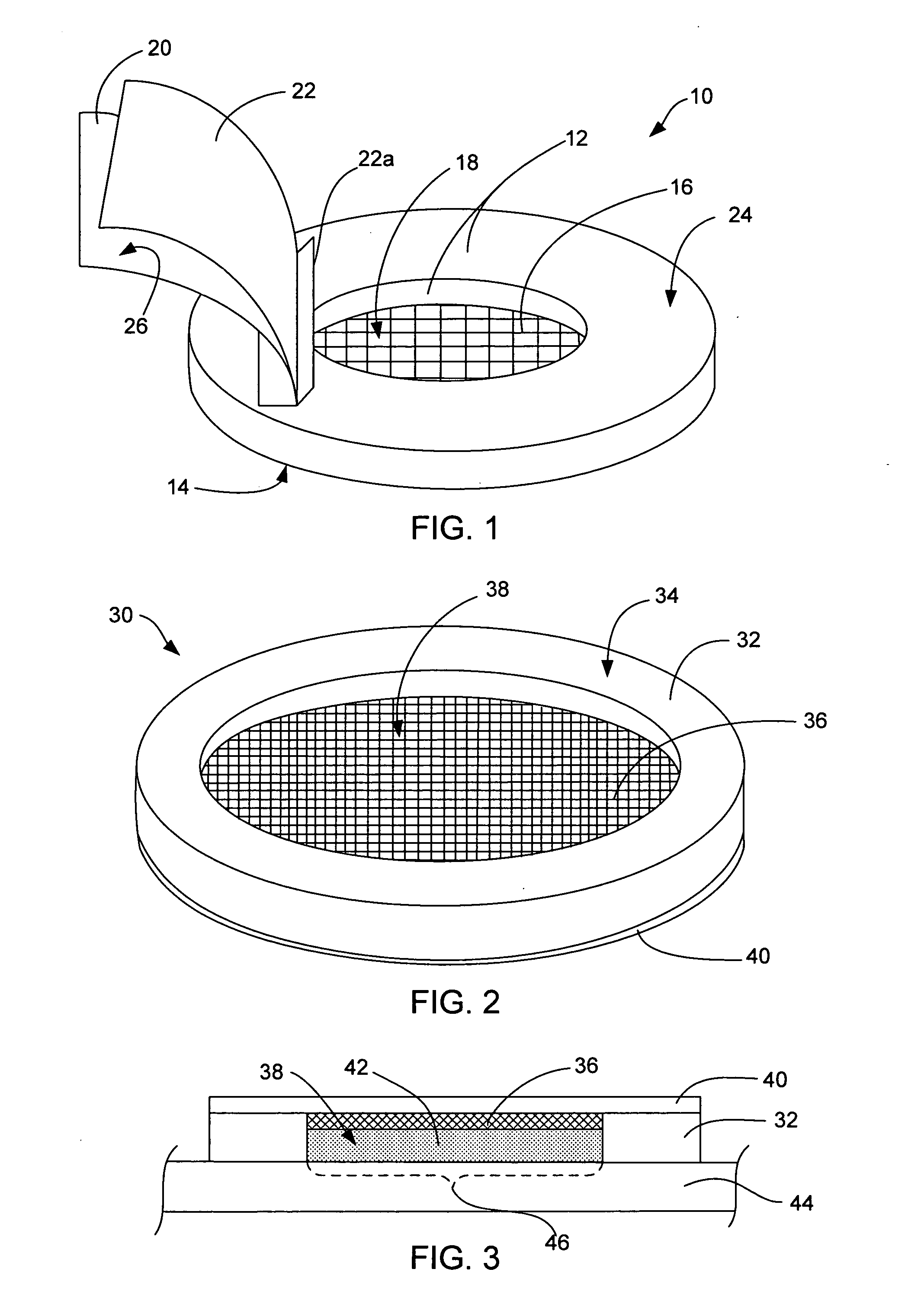Instant patch for dermal drug delivery
- Summary
- Abstract
- Description
- Claims
- Application Information
AI Technical Summary
Benefits of technology
Problems solved by technology
Method used
Image
Examples
example 1
[0052] A cavity patch is prepared having a configuration similar to that in FIG. 1 (top loading). A drug-containing composition (solution) containing an active drug and 15% polyvinyl alcohol in water. The cavity patch contains an absorbent mesh material which is a thin layer of absorbent gauze impregnated with about 5 mg / cm2 sodium borate, and which is adhered on the underside of the ring-shaped patch wall (made from a soft, flexible foam tape) such that the mesh covers, but does not close, the lower end of the cavity in the ring. An impermeable cover is made of an impermeable tape (such as the 1525 adhesive tape by 3M) with a release liner covering the adhesive side.
[0053] To use the system, the user first affixes the cavity patch onto the skin so that the adhesive layer firmly seals the bottom of the patch onto the skin. Eight one hundredth of a milliliter of the drug-containing composition is dispensed onto the mesh and spreads over the skin area defined by the cavity. The user ...
example 2
[0054] The drug-containing composition (solution) and materials in the cavity patch are the same as those in Example 1, but the configuration of the cavity patch is the bottom-loading type as shown in FIG. 2. An amount of drug-containing composition is dispensed into the open cavity of the cavity patch prior to adhesion of the patch to the skin. After the drug-containing solution is dispensed into the open cavity, the user affixes the cavity patch to the skin using the adhesive layer which is coated on the bottom of the cavity patch wall. This seals the patch to the skin and seals the drug-containing composition in the open cavity. The drug-containing composition gels into a soft solid and leaves no residue when the cavity patch and gel are removed at the end of the intended administration period.
example 3
[0055] Four cavity patches having the configuration as shown in FIG. 2 and containing 0.5, 1, 2, and 4 mg / cm2 borate are studied to determine an optimal amount of borate (a gel-triggering agent) needed to gel a 15% polyvinyl alcohol (PVA) (a gelling agent) solution. The open cavity is 3 mm deep by 14 mm in diameter, and the absorbent material is a thin layer of nonwoven film impregnated with borate. The nonwoven material is affixed to the underside of the impermeable cover (3M 1523 polyethylene film) such that the nonwoven film covers the entire area of the open cavity. Specifically, the cavity patches containing 0.5, 1, 2, and 4 mg / cm2 borate are each dosed with approximately 0.5 mL of a 15% PVA in water formulation, so that the filled open cavity has roughly 50 mg PVA per cm2. The borate to PVA ratios per unit area for the patches are approximately 1:100, 2:100, 4:100 and 8:100, respectively. Each patch is then affixed to the upper arm of a study volunteer. After 3 hours, one side...
PUM
 Login to View More
Login to View More Abstract
Description
Claims
Application Information
 Login to View More
Login to View More - R&D
- Intellectual Property
- Life Sciences
- Materials
- Tech Scout
- Unparalleled Data Quality
- Higher Quality Content
- 60% Fewer Hallucinations
Browse by: Latest US Patents, China's latest patents, Technical Efficacy Thesaurus, Application Domain, Technology Topic, Popular Technical Reports.
© 2025 PatSnap. All rights reserved.Legal|Privacy policy|Modern Slavery Act Transparency Statement|Sitemap|About US| Contact US: help@patsnap.com

